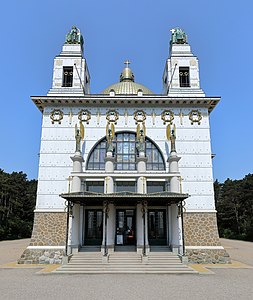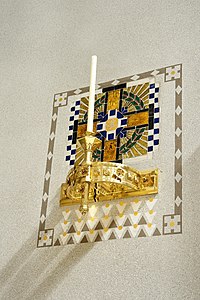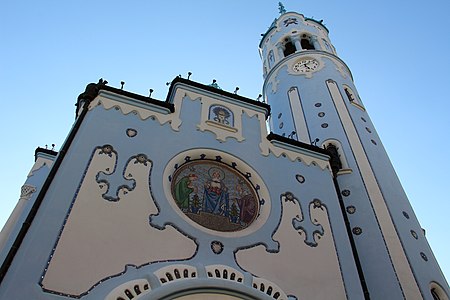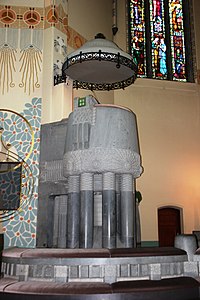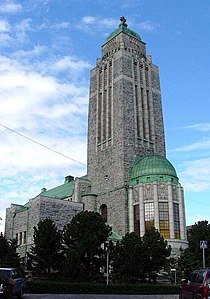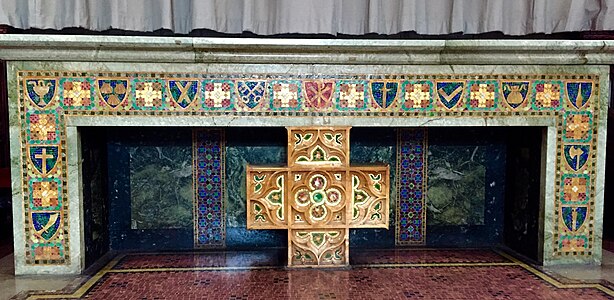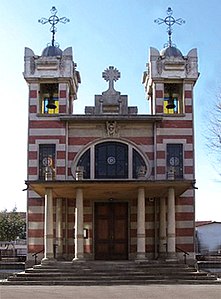Art Nouveau religious buildings
Art Nouveau temples are churches, chapels, synagogues, and mosques built in the style known as
Art Nouveau churches of Spain
-
Nativity Façade of Sagrada Família basilica in Barcelona
-
Interior of Sagrada Família basilica in Barcelona
-
Interior of the Carmen church (1911-1913) in Barcelona
-
The stained glass windows of the Christ church in Province of Teruel
The only churches that are designated UNESCO World Heritage List sites are works of Antoni Gaudí:[1] Sagrada Família basilica in Barcelona (1882–) that is still under construction and Church of Colònia Güell in Santa Coloma de Cervelló, province of Barcelona, that Gaudí along with Francesc Berenguer i Mestres and Joan Rubió left unfinished in 1914.
Sagrada Família is not pure Art Nouveau: its construction started before the movement incepted with a
Sagrada Família was a vague inspiration[2] for the construction of Sanctuary of Maria Magdalena by José Sala Sala in Novelda of the Catalan-speaking Valencian Community. Though the construction started in 1918 and finished in 1946, this church is regarded as a valuable monument of Valencian Art Nouveau.[2]
Another example of a Modernisme church in Catalonia is the Carmen church (1911-1913) in Barcelona by Josep Maria Pericas, an example of modernisme church by a Catalan architect in another part of Spain – the Christ church (1910-1912) in the Province of Teruel by Pau Monguió i Segura.
Art Nouveau churches of France
-
The stained glass window ofSaint-Jean-de-Montmartre in Paris
-
Ceramics ofSaint-Jean-de-Montmartre, Paris
The church of
Another Art Nouveau religious building in Paris is Agoudas Hakehilos Synagogue (1913-1914) by Hector Guimard, who was not only the architect, but also created furnishings (luminaires, chandeliers, brackets, and benches), as well as the stylized vegetal decorations and the cast iron railings.
An Art Nouveau artist Eugène Grasset designed mosaics and stained glass windows (done by Félix Gaudin) for Saint-Étienne church (1890-1895) in Briare, Centre-Val de Loire.
Art Nouveau churches of the British Empire
-
Interior ofSir William Reynolds-Stephens in Great Warley, Essex
The only actually built church of the pioneer of Glasgow style Charles Rennie Mackintosh is the Queen's Cross Church (1898-1899) in Glasgow. An Art Nouveau design[3] by Bradshaw and Gass had a former Methodist church (1905) in Liverpool now hosting the Grand Central Hall, Hotel, and Grand Bazaar Food Hall.
Churches that have Art Nouveau features are:
- Mary Fraser-Tytler.[4]
- Sir William Reynolds-Stephens,
- St Matthew's Church (1905-1907) in Paisley, Scotland with the stained glass window by Robert Anning Bell and architecture by William Daniel McLennan, that is described as an Art Nouveau interpretation of Perpendicular Gothic.[5]
Jugendstil churches of the German Empire and Switzerland
-
Portal of the Protestant Church in Wilnsdorf, North Rhine-Westphalia
Churches with both Jugendstil exterior and interior are the Luther church in Wiesbaden, Hesse (1908-1911) [6] by Friedrich Pützer and Protestant Church in Wilnsdorf, North Rhine-Westphalia (1911-1913) by Gustav Mucke. Luther church in Wiesbaden is considered "a harmoniously composed Gesamtkunstwerk of German Protestant culture".[7]
Another notable Jugendstil church is
Jugendstil elements of
Jugendstil churches were built not only in Europe but also in German colonies in Africa and Asia. Lutheran church in
Secession temples of Cisleithania (Austria)
-
Lamp in St. Charles Borromeo Cemetery Church in Vienna
-
Frescoes of Peter and Paul Basilica in Prague
Many well-known Vienna Secession artists were occupied in the construction of Kirche am Steinhof (1903-1907) in Vienna: Otto Wagner was the architect, mosaics and stained glass windows were designed by Koloman Moser and Rudolf Jettmar and made by Leopold Forstner, sculptural angels were made by Othmar Schimkowitz.[13] Leopold Forstner also created stained glass windows for St. Charles Borromeo Cemetery Church (1911-1913), also in Vienna, built to designs by the architect Max Hegele.
Notable Art Nouveau frescoes can be found in Peter and Paul Basilica in Prague, made by František Urban and his wife Marie Urbanová-Zahradnická.
Famous Czech painter Alphonse Mucha created stained glass windows for St. Vitus Cathedral in Prague. Though created in the 1930s, when Art Nouveau has already faded, his style remained unchanged.
Some Art Nouveau features can be found in the interior of Jubilee Synagogue in Prague.
Szecesszió temples of the Kingdom of Hungary
The pioneer and prophet of the Szecesszió (Secession in Hungarian), the architect Ödön Lechner[14] created several churches as well. His Saint Ladislaus church in Kőbánya (1894-1899) is regarded as eclectic with Szecesszió features, while Blue Church (1909-1913) in Pozsony (present-day Bratislava) is truly Szecesszió.
Lechner's disciples Marcell Komor and Dezső Jakab were commissioned to build the Synagogue in Szabadka (now Subotica, Serbia) in 1901–1903. Included into the List of 100 Most Endangered Sites in the World, it has undergone a full restoration completed in 2018.[15]
Another notable Hungarian architect was Károly Kós. His Roman Catholic churches in Zebegény, Hungary (1908–09) and Cluj-Napoca, Romania (1913–1914) are regarded at National Romantic.[16] Similar to his style the Fasori Reformed Church (1911-1913) by Aladár Árkay was built in Budapest. The church in Zebegény was painted by Aladár Körösfői-Kriesch, the founder of Gödöllő Art Colony.
National Romantic churches in Grand Duchy of Finland
-
Interior of the cathedral with frescoes by Hugo Simberg in Tampere
-
Interior of Oulujoki Church by Victor J. Sucksdorff in Oulu
Several dozens of National Romantic churches were built in
Josef Stenbäck was the architect of more than a dozen National Romantic churches throughout the Grand Duchy, e.g. Karuna Church (1908–1910). Three of the churches are now at the territory of Russia.[nb 1]
A notable example of wooden Art Nouveau church is Oulujoki Church (1907–1908) in Oulu by Victor J. Sucksdorff[17]
National Romantic churches in Sweden, Norway, and Denmark
-
The altar of the Ålesund Church, Norway
Churches with National Romantic altars in Sweden are Engelbrekt Church in Stockholm (1910-1914) and wooden Kiruna Church (1909-1912, the altar by Prince Eugen, Duke of Närke). St. John's Church (1903-1906) in Malmö and Masthugg Church (1907-1914) in Gothenburg are also notable. In Denmark, Swedish Gustaf's Church (1908-1911) in Copenhagen can be noted.
In Norway, the example of a stone and brick National Romantic church is Lademoen Church (1903–05) in Trondheim. In Ålesund, a church completed in 1909 was built in Art Nouveau style along with many other buildings in the city.[18] Neo-Gothic church in Skien (1894) features Art Nouveau stained glass windows. Other examples of churches built in a mix of Neo-Gothic and National Romantic styles are Fagerborg Church and Vålerenga Church (both - in Oslo).
Temples of Modern Style in the Russian Empire
-
Church of the Holy Spirit in Talashkino
-
Old Believers chapel in Ryabushinsky House by Franz (Fyodor) Schechtel in Moscow
-
Maiolica mural at Resurrection church by masters of Abramtsevo Colony in Vichuga (1880s)
Most
Another church with
While the former churches are Orthodox, there were numerous Old Believers churches built throughout the Empire as the restriction to build them was withdrawn in 1905. Two churches were built by Ilya Bondarenko in Moscow. Franz (Fyodor) Schechtel built an Old Believers chapel at the upper floor of the house of tycoon Stepan Ryabushinsky.
As Saint Petersburg was situated close to the border with Grand Duchy of Finland, there was a strong influence of its National Romantic style on local Art Nouveau Architecture, to temples as well. In Russian National Romantic style is called Severny modern literally meaning "Northern Art Nouveau". Though the Saint Petersburg Mosque (1909-1920) by Nikolai Vasilyev has Iranian architecture, some of its features are clearly National Romantic.[20][21][22]
Art Nouveau churches of the United States
-
A lamp atWillard Memorial Chapel by Louis Comfort Tiffany in Auburn, New York
-
The Christ on the Waters stained glass window at Naval Academy Chapel by Frederick Wilson in Annapolis, Maryland
Several churches and chapels in the United States have interior details crafted by Louis Comfort Tiffany:
- Altar: Fourth Universalist Society in the City of New York,
- Stained glass windows and interior: Willard Memorial Chapel (1892-1894) in Auburn, New York
- Stained glass windows:
- Brown Memorial Presbyterian Church in Baltimore (1905),
- First Presbyterian Church, Lockport, NY
- Arlington Street Church in Boston (1899-1929)
- Pullman Memorial Universalist Church, Albion, NY
- Second Presbyterian Church in Chicago
- Wade Memorial Chapel in Cleveland
Tiffany's chief designer for ecclesiastical windows was
A notable mix of the Prairie School and Art Nouveau styles is the Church of St. Bernard (1905–1914) by John Jager in Saint Paul, Minnesota.
Liberty churches in Italy
-
Church of Saint Elizabeth in Villaggio Leumann, Collegno, near Turin, Italy.
-
Church of Sacred Heart in Milan, Italy.
-
Façade of the Cathedral of Saint Julian in Caltagirone, Sicily, Italy.
Notes
References
- ^ https://whc.unesco.org/en/list/320/multiple=1&unique_number=364 Official List of the UNESCO Site "Works of Antoni Gaudí" (1994, 2005)
- ^ a b "Art Nouveau European Route: Buenos Aires". www.artnouveau.eu.
- ^ Pollard, Richard; Pevsner, Nikolaus (2006). The Buildings of England - Lancashire: Liverpool and the south-west. Yale University Press. p. 285.
- ^ "Watts Chapel". Guildford Council. Archived from the original on 14 September 2007. Retrieved 19 December 2008.
- ^ [1] ST MATTHEW'S CHURCH - Historic Environment Scotland
- ^ Bökenkötter, Heike (30 December 2010). "Kirchenraum mit orientalischem Charme" (in German). Frankfurter Rundschau. Retrieved 9 July 2015.
- ^ Dienst, Karl (2003). "Kirchenraum mit orientalischem Charme" (PDF). Umbruch (in German). ekkw.de. Retrieved 24 July 2015.
- ^ "Pauluskirche Bern". Gody Hofmann. Retrieved 2012-02-11.(in German)
- ISBN 978-1-84836-471-4. Retrieved 11 February 2012.
- ^ "Paulus Church, Basel, Switzerland". All About Switzerland. Retrieved 2010-09-04.
- ISBN 3-422-03071-9.
- ^ "Namibia Tourist Attractions and Sightseeing". World Guides. Retrieved 15 October 2016.
- ISBN 9780521478861.
- ^ "The "Coup de Fouet" magazine, vol. 23 (2014), pp. 2–35" (PDF).
- ^ "The "Coup de Fouet" magazine, vol. 31 (2019), pp. 60–69" (PDF).
- ^ "The "Coup de Fouet" magazine, vol. 8 (2014), pp. 37–41" (PDF).
- ISBN 978-952-99248-3-7.
- ^ "The "Coup de Fouet" magazine, vol. 33 (2020), pp. 3–15" (PDF).
- ^ Journal of UralNIIProject RAASN — 2014. — No. 2. — p. 27—32. — ISSN 2074-2932 (in Russian)
- ^ Vityzeva V.A. Saint Petersburg Mosque — a monument of National Romanticism in Saint Petersburg // History of Saint Petersburg. — SPb., 2002. — No. 1. (in Russian)
- ^ [2] Saint Petersburg Mosque — Citywalls.ru (An architecture website of Saint Petersburg, in Russian)
- ISBN 978-5-4462-0083-2.
- ^ "About Tiffany Windows". ASC Tiffany. Foundation for the Preservation of 20 Arlington Street. Retrieved 2017-05-16.
- ^ "Tiffany's Rare 1893 Chapel Opens at the Morse Museum". Charles Hosmer Morse Museum of American Art. 1999. Retrieved January 16, 2011.




![Sanctuary of Maria Magdalena [ca] in Novelda](http://upload.wikimedia.org/wikipedia/commons/thumb/2/28/Santuario_Novelda.jpg/225px-Santuario_Novelda.jpg)
![Interior of the Carmen church [ca] (1911-1913) in Barcelona](http://upload.wikimedia.org/wikipedia/commons/thumb/d/d2/Barcelona_-_Esgl%C3%A9sia_de_Nostra_Senyora_del_Carme_%28El_Raval%29%2C_interior_01.jpg/225px-Barcelona_-_Esgl%C3%A9sia_de_Nostra_Senyora_del_Carme_%28El_Raval%29%2C_interior_01.jpg)
![The stained glass windows of the Christ church [es] in Province of Teruel](http://upload.wikimedia.org/wikipedia/commons/thumb/1/16/Ermita_modernista_de_Villaspesa_3.jpg/225px-Ermita_modernista_de_Villaspesa_3.jpg)



![Mosaic of Saint-Étienne church [fr] by Eugène Grasset in Briare](http://upload.wikimedia.org/wikipedia/commons/thumb/5/53/%C3%89glise_Saint-%C3%89tienne_de_Briare_3.JPG/400px-%C3%89glise_Saint-%C3%89tienne_de_Briare_3.JPG)










